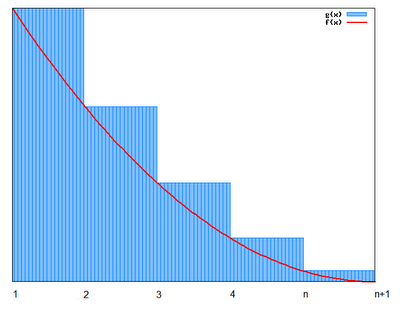The content in today's blog is taken from Edwards and Penney, Calculus and Analytic Geometry.
Definition 1: Improper Integral
An Improper Integral is an integral on an interval that is open (does not include its endpoints) or on a closed interval that is unbounded (that is, one of its endpoints is either ∞ or -∞). [See here for a review of open and closed intervals]
Improper integrals are used to analyze infinite series. The improper integral is the limit of a sequence of definite integrals where endpoints get closer and closer to the limit.
Theorem 1: The Integral Test
Let ∑ an be a positive-term series (none of the elements are negative) and let f(x) be a function that is a positive valued, decreasing continuous function for x ≥ 1.
If f(n) = an for all integers n ≥ 1, then the series and the improper integral:
∑ (n=1, ∞) an
∫ (1,∞) f(x)dx
either both converge or diverge. That is, one diverges if and only if the other diverges.
Proof:
(1) Let Sn = a1 + a2 + ... + an
(2) If f(n) = an for all integers n ≥ 1, then it is clear that for the region under y=f(x) from x=1 to x = n+1:
∫ (1,n+1) f(x)dx ≤ Sn (see graph below)
 (3) If we now consider the sum Sn - a1 = a2 + a3 + ... + an, then:
(3) If we now consider the sum Sn - a1 = a2 + a3 + ... + an, then:If f(n) = an for all integers n ≥ 1, then it is clear that for the region under y=f(x) from x=1 to x = n:
Sn - a1 ≤ ∫ (n,1) f(x)dx (see graph below)
 (4) Assume that ∫(∞,1) f(x)dx diverges.
(4) Assume that ∫(∞,1) f(x)dx diverges.Then it goes to +∞ since by assumption f(x) is a positive term series.
(5) lim (n → ∞) ∫ (n+1,1) f(x) = +∞
(6) From step #2, it is clear that lim (n → ∞) S
(7) Assume that ∫(∞,1) f(x)dx converges with value = I.
(8) From step #3,
Sn ≤ a1 + ∫(n,1)f(x)dx ≤ a1 + I
(9) So the monotone increasing sequence {Sn} (∞,1) is bounded. [See Definition 8, here for definition of monotone increasing sequence, see Definition 4, here for definition of bounded]
(10) This gives that the infinite series ∑ an = lim (n → ∞) Sn converges also.
QED
Corollary 1.1: Harmonic series diverges
∑ (n=1, ∞) 1/n = 1 + 1/2 + 1/3 + 1/4 + ...
Proof:
(1) f(x)=1/x is positive, continuous, and decreasing for x ≥ 1.
(2) ∫(∞,1) (1/x)dx = lim (b → ∞) ∫ (b,1) (1/x)dx = lim (b → ∞) [ln x] (b,1) [This follows from the derivative of 1/x, see Lemma 1, here]
(3)
(4) Therefore, using the Integral Test above, the series diverges.
QED
Corollary 1.2: Zeta function converges if s > 1 but diverges if 0 is less than s ≤ 1.
ζ(s) = ∑ (n=1,∞) 1/ns = 1 + 1/2s + 1/3s + ... + 1/ns + ...
Proof:
(1) The case where s=1 was proven in Corollary 1.1
(2) If s is greater than 0 and s ≠ 1, then f(x) = 1/xs satisfies the conditions of the integral test (it is a positive-valued, decreasing, continuous function for x ≥ 1).
(3) ∫ (∞,1) (1/xs)dx = lim (b → ∞) ∫ (b,1) (1/xs)dx = lim (b → ∞) [-1/[(s-1)xs-1]] (b,1) [This follows from the power rule for derivatives (see Lemma 2, here) and the fundamental theorem of calculus]
(4)
(5) If s is greater than 1, then:
lim(b → ∞) (1/[s-1])[1 - 1/(bs-1)] = (1/[s-1])(1) = (1/[s-1]) which is less than ∞ so it converges.
(6) If 0 is less than s is less than 1, then:
∫ (∞,1)(1/xs)dx = lim (b → ∞) [1/(1-s)](b1-p - 1) = ∞
[This follows from the generalized power rule for derivatives (see Theorem, here) and the fundamental theorem of calculus]
(7) The conclusion follows from the Integral Test above.
QED
References
- Mohamed A. Khamsi, "Improper Integrals: An Introduction", SOSMath.com
- Edwards & Penney, Calculus and Analytic Geometry
No comments :
Post a Comment